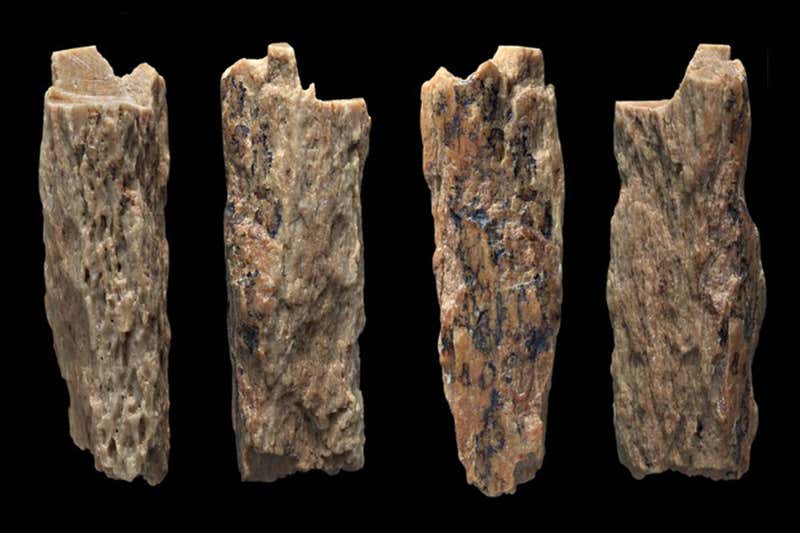Hybrid Hominin: This Girl’s Mother and Father Came From Two Different Species

Hybrid Hominin: This Girl’s Mother and Father Came From Two Different Species
A sliver of bone from a cave in Russia is at the center of what may be the biggest archeological story of the year. The bone belonged to an ancient human who had the mother of Neanderthal and a father of Denisovan. “Denny” is the only hybrid hominin of first-generation ever found.

Viviane Slon from the Max Planck Institute for Evolutionary Anthropology in Leipzig says: “My first reaction was unbelief.
The find is either an amazing stroke of luck or an indication that the hominins interbred more often than we thought. It can even suggest that extinct groups like Neanderthals have been absorbed by our species and have not died out.
In prehistory, members of our species are interspersed with at least two other ancient humans: the Neanderthals and the mysterious Denisovans known only from bone and teeth fragments found in the Denisova cave, Russia. Neanderthals and Denisovans also interbred and Denisovans carried the genes from unidentified hominins.
These interbreeding events were thought to be rare. “The likelihood of actually finding a [first-generation] hybrid has always been considered infinitesimally low,” says Katerina Harvati-Papatheodorou at the University of Tübingen, Germany.
A sliver of bone
A few years ago, archaeologists found a 90,000-year-old bone fragment in Denisova cave. Samantha Brown, then at the University of Oxford, discovered that it came from a hominin by examining the proteins preserved inside it. Her team nicknamed the hominin “Denny”. Based on the structure of the bone, Denny died at about 13 years of age.
Slon and her colleagues have now examined Denny’s DNA, discovering that Denny was female – and that she had astonishing parentage. Her DNA was almost 50:50 Neanderthal and Denisovan, arranged in a tell‑tale way.
Our DNA comes in paired strands called chromosomes, one from each parent. In Denny’s case, each pair had one Neanderthal and one Denisovan chromosome, with very little mixing. She was the daughter of parents from different species.
Denny’s mitochondrial DNA, which is inherited only from mothers, is Neanderthal. Therefore, her mother was Neanderthal and her father Denisovan.
Experts contacted by New Scientist all accept the finding. “They nail it,” says Pontus Skoglund of the Francis Crick Institute in London, UK. “There seems to be no uncertainty at all.”
Denny is an enigma, says Harvati-Papatheodorou. “Since her known remains consist of an unidentifiable bone fragment, it is very difficult to say anything about her daily life, activities, health or subsistence.”
Breeding freely
Only 23 ancient hominins have had their genomes sequenced. Yet Denny is not the first with recent shared ancestry. There is also “Oase 1”, a member of our species who lived 37,000 years ago in what is now Romania. They had a Neanderthal ancestor just four to six generations earlier.
If interbreeding were rare, we should not have found these individuals so easily, says Svante Pääbo, also of the Max Planck Institute for Evolutionary Anthropology. “It suggests that these groups, when they met, mixed quite freely with each other.”
This doesn’t mean Neanderthals and Denisovans were constantly interbreeding. Their genomes show they were “quite distinct populations”, says Pääbo. They controlled separate territories – the Neanderthals in Europe, the Denisovans in east Asia – and occasionally met at the boundaries. He says the Denisova cave was “a unique area where they met, and then they had no prejudices against each other”.
“The evidence is growing that interbreeding among different human lineages was more common than previously thought,” agrees Harvati-Papatheodorou. They had good reason. “Human groups were very small and vulnerable to drastic mortality,” she says. Interbreeding may have been a good way to find a mate.
Pääbo argues that when modern humans expanded from Africa into Europe and Asia, they often interbred with Neanderthals and Denisovans.
This could be why these groups vanished. “Neanderthals and Denisovans may not have become violently extinct, but may have become absorbed into modern human populations.”
It’s a possibility but we can’t be sure, says Joshua Akey of Princeton University in New Jersey. “Although this study is consistent with the idea of assimilation, it does not rule out a more complicated mixture of factors, including competition.”